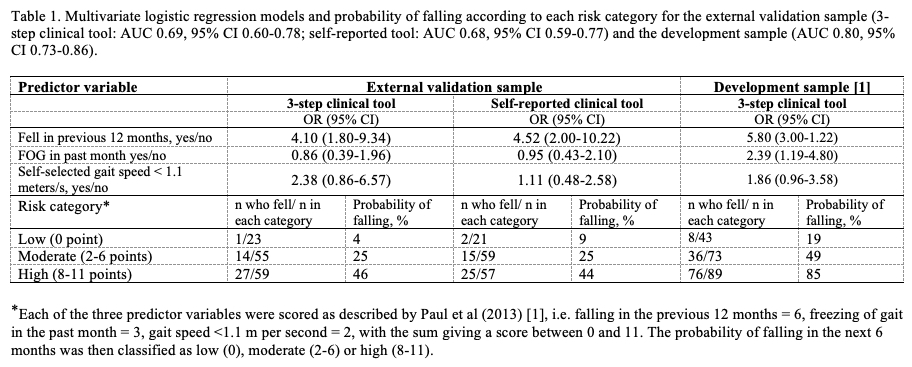Objective: To externally validate the 3-step clinical prediction tool for identifying people with Parkinson’s disease (PD) at risk of falls; to validate this tool using only self-report measures (self-reported prediction tool).
Background: A simple 3-step clinical prediction tool has shown high accuracy (area under the receiver-operating characteristic curve [AUC]= 0.80; 95% CI 0.73–0.86) in predicting falls in the next 6 months [1]. Predictors in this tool include falling in the previous 12 months, freezing of gait (FOG) in the past month and self-selected gait speed <1.1 m/s. The accuracy of this tool when including only self-report measures (i.e. substituting timed self-selected gait speed with self-reported gait speed) is yet to be determined.
Method: 137 people with PD were followed-up for 6 months. Participants were classified as having FOG if they scored ≥1 on question 3 of the FOG questionnaire. Timed self-selected gait speed was determined from the mean of two trials over 4 meters. Participants answered the question: “when considering people the same age as you but without PD, would you say your gait speed is the same, faster or slower than these people?” Response to the question compared with timed gait speed (reference level of 1.1 m/s) was used to determine the accuracy of self-reported gait speed. Multivariate logistic regression models were used to evaluate the performance of the predictor variables in each tool. The discriminative ability of the 3-step clinical and self-reported falls prediction tools were determined using AUCs.
Results: 42 (31%) participants reported at least one fall during the six-month follow up. 86 (63%) individuals correctly identified their gait speed compared to the reference speed of 1.1 m/s. Multivariate models revealed that only falling in the previous 12 months was an independent predictor of falls in both tools [table 1]. The 3-step clinical prediction tool had an AUC=0.69; 95% CI 0.60–0.78. Similar results were found for the 3-step self-reported prediction tool (AUC=0.68; 95% CI 0.59–0.77).
Conclusion: The clinical falls prediction tool showed acceptable accuracy in this external validation study. The lower accuracy may be due to the similar distribution of freezers among fallers and non-fallers compared to the development sample. The self-reported falls prediction tool was validated and may be an appropriate tool for use in e/tele-health to identify people with PD at risk of falls.
References: [1] Paul SS, Canning CG, Sherrington C, Lord SR, Close JC, & Fung VS (2013) Three simple clinical tests to accurately predict falls in people with Parkinson’s disease. Mov Disord, 28, 655-662.
To cite this abstract in AMA style:
L. Almeida, H. Meira, M. Piemonte, C. Canning, S. Paul. Clinical and self-reported falls prediction tools in people with Parkinson’s disease [abstract]. Mov Disord. 2020; 35 (suppl 1). https://www.mdsabstracts.org/abstract/clinical-and-self-reported-falls-prediction-tools-in-people-with-parkinsons-disease/. Accessed December 31, 2025.« Back to MDS Virtual Congress 2020
MDS Abstracts - https://www.mdsabstracts.org/abstract/clinical-and-self-reported-falls-prediction-tools-in-people-with-parkinsons-disease/

